
Erin | M/V Kestrel | 11:00 AM | Tuesday, September 3, 2019
What a wonderful trip aboard Kestrel this afternoon! We began our trip with no firm reports of whales in the area, so we decided to head north in search of some whales. Right after we left the harbor, we saw a bald eagle perched in one of the treetops! It was an adult bald eagle, with a bright white head and some white tail feathers. As we headed through San Juan Channel, we saw some upwelling occurring around us. Upwelling brings nutrients up to the surface of the water and allows for phytoplankton to grow, which is at the base of the food chain. We went into Spieden Channel and ended up seeing a whole bunch of wildlife on Spieden Island. The first type of wildlife we saw was a mouflon sheep. Mouflon sheep appear as deer, but they are actually an exotic species from Corsica. They were brought to the island in the 1970's. We then continued along the shoreline and saw many more mouflon sheep alll along the hillside. Some of them were also at the water's level eating algae off of the rocks and drinking freshwater out of springs. We also saw another bald eagle perched in a treetop! There were harbor seals hauled out on the shore as well. The seals were swimming around in the water and we saw many of them actively haul out on the rocks. It was quite exciting.
We then decided to stop past Turn Point, which is the most northwestern point in the contiguous United States. There is a lighthouse on Turn Point and a cliffside that is important for nesting seabirds. We got to see some cormorants with their nests. We crossed Haro Strait and saw a baitball in the distance. Baitballs occur when schooling fish are driven into a spherical formation because of the presence of larger predators like salmon, seals, porpoises, or whales. This baitball was one of the coolest ones I have ever seen! The birds were grabbing fish out of the water and we saw 3 harbor seals grabbing some of the fish as well! We saw 2 of the seals swim directly next to our boat. One of them came up to the surface and looked directly at us for about 10 seconds! It was so incredible! All around us, there were bird feathers and fish scales floating in the water. At one point, we could even see the school of fish just under the surface of the water! After seeing the baitball, we headed in the direction of some killer whales that had been reported!
The killer whales were travelling from Sidney Island toward Moresby Island when we came across them. They were a pod of Bigg's killer whales, which are the marine mammal eaters. There were 8 whales in the pod. Six of them were identified as the T60's. T60 is the mother and the matriarch. She is believed to be about 40 years old. Her eldest son is 18, and he is massive. He is most likely not even fully grown, as we believe that physical maturity occurs in their early 20's. The rest of T60's offspring were present as well, including one new calf! The other whales that were travelling with the pod were identified as T59 and T02B. They are believed to be unrelated to the T60's, but are seen travelling with them often. The whales seemed to be hunting, as they were travelling in very random directions and circling back toward each other at times. We even got to see one of the adults spyhop! It was such a treat! After watching the whales, we headed back toward Friday Harbor, making sure to spot for other wildlife along the way. There were some harbor porpoises that popped up every now and then, but otherwise it was just a peaceful ride back. We arrived back at the harbor with memories to last a lifetime! Until next time, folks!
Naturalist Erin